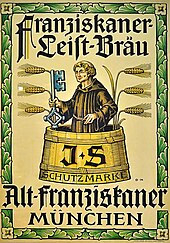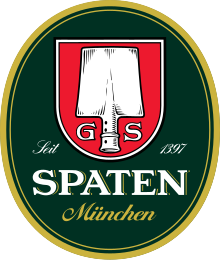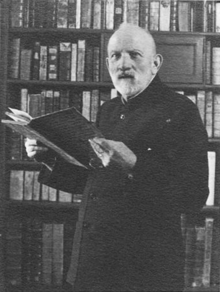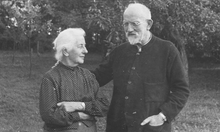Otto Hupp
Hermann Otto Joseph Hubert August Constantin Hupp (* 21st May 1859 in Dusseldorf , † 31 January 1949 in Oberschleißheim ) was a German heraldry , signature graphic artists , painter , collector and engraver .
Life
Otto Hupp was born in Düsseldorf as the fourth of five sons of the engraver and medalist Carl Heinrich Hupp (1823–1906) and Marie Hupp, b. Ruland, born. His father made sure that Otto Hupp did an engraving apprenticeship with him while he was still at school. Soon after completing his training, he attended the Düsseldorf Art Academy and moved to Munich in 1878. From 1891 until his death he lived in the Munich suburb of Oberschleißheim.
Heraldic work

From the 1880s onwards, Otto Hupp's main field of work was heraldry . He learned many painting techniques from the Munich painter Rudolf Seitz , and through contact with the architect Gabriel von Seidl , he received several commissions for wall and ceiling paintings, for example the paintings in the Imperial City Archive in the town hall in Worms (1882–86) and the paintings in the Gottliebenkapelle in Worms-Herrnsheim . Among other things, he carried out the heraldic concept and the execution in the refreshment room ( Wallotbräu ) of the Reichstag building in Berlin. The design of stained glass windows with heraldic motifs was also part of his range of craftsmanship. B. Additions in the Katharinenkirche in Oppenheim (1899), windows in the Magnuskirche in Worms (1932/33), unexecuted drafts for the landgrave choir of the Elisabethkirche in Marburg (1938/39).
Through his collections of old heraldic books and heraldic literature, he perfected his craft in the years to come . He painted more than 6000 coats of arms, including the coat of arms of his native city , and wrote several books on heraldry. The series of coats of arms and seals of the German cities, towns and villages was published from 1894, but he was only able to complete 5 of the originally planned 10 (or 11) volumes. 3460 of his coat of arms pictures were published as trading cards by the Kaffee HAG company in the years 1913–1918 and 1926–1938. These collector's pictures in particular contributed to bringing the art of heraldry closer to the general public.
Hupp not only documented the existing coats of arms of the cities and municipalities, but also drew many drafts, which then became the basis of the official coats of arms. So he designed z. B. 1930 the coat of arms of the new city Krefeld-Uerdingen on the Rhine .
One of his most important coat of arms designs was the Bavarian state coat of arms from 1923, which however was replaced by a modernized version after the Second World War. Other national coats of arms also come from his hand, for example. B. the coat of arms of the Prussian province of Upper Silesia , created in 1919, and the coat of arms for the People's State of Hesse .
Another heraldic publication by Otto Hupp was the Munich calendar , 51 of which appeared in the years 1885–1936 (with the exception of 1933). The calendars for the years 1885 to 1894 showed monthly coats of arms with the signs of the zodiac. It was not until 1895 that Otto Hupp was able to assert himself with his idea, instead of the “worn month signs” of the coats of arms of the German princely houses and then annually a double-page coat of arms of a German state and then each twelve coats of arms of major noble families.
The first year in 1885 was printed in an edition of around 5000 copies. The print run increased to 17,000 copies in 1913 and 1914. From 1915, however, the print run steadily decreased, in 1932 only 4,000 copies were printed, a large number of which could no longer be sold. So the publisher felt compelled to discontinue the Munich calendar, which is why no Munich calendar was published in 1933. The following years of the Munich calendar (1934, 1935 and 1936) were self-published by Otto Hupp. The 1934 and 1936 calendars differ in their design from the calendars up to 1932. The 1934 calendar shows six smaller coats of arms per month. The 1936 calendar appeared as a tear-off calendar with 52 coats of arms. Even if Otto Hupp was able to fulfill his wish to publish the 50th year of his Munich calendar, he finally had to realize that economic success was denied to his own initiative.
He wrote innumerable essays on individual heraldic questions and worked on several special works. In his 1918 work, Against the Swarming Spirits, he refuted the rune theory that had come into fashion at the time, along with other false doctrines .
Commercial graphic work

He made his first work as a font designer in 1883. The first complete font, Neudeutsch , was published in 1899 by Genzsch & Heyse. He designed some more headlines like Hupp-Gotisch , Hupp fracture or Hupp-Antiqua , [s] but since they were not intended as everyday use fonts found no widespread.
His specialty also included the creation of commercial graphics. The Spaten brewery's company emblem is probably the best-known here; he designed many beer and wine labels, as well as banknotes, postage stamps and over 200 bookplates . He created well over 10,000 individual works in his working years. Other works by Otto Hupp were, for example, handcrafted metalwork for the Speyer Cathedral , for which he was awarded the title of Professor in 1906 by Prince Regent Luitpold of Bavaria .
Although he was undoubtedly an artist, he always insisted not to be called such - he saw himself more as a craftsman.
Collector
Otto Hupp collected from a passion for collecting as well as from professional interest, especially heraldic documents, original certificates with seals , which served him as templates and suggestions for his heraldic and graphic endeavors described above, as well as incunabula and old prints that interested him as a typographer and type designer. Based on his own collection, he dealt with questions of early printing, especially with the beginnings of the printing art of Johannes Gutenberg , whose earliest work he believed to have discovered. Around 1880 he had acquired what was supposed to be a Konstanz missal , the type of which Hupp saw as a preliminary form of the Psalter from 1457 by Fust and Schöffer and thus as a product of Gutenberg before his famous Bible. Hupp published his find in 1898 and entrusted the incunable to the well-known Munich antiquarian Ludwig Rosenthal , who advertised it in his 100th catalog in 1900. Hupp bought many books from Rosenthal in the hope of a big profit from the sale of the Missal, but this failed, not only because of the high price, but also because of doubts about the early dating. Hupp had to take the work back and gradually pay off his debts. After Hupp's death, the Missal was bought by the Bavarian State Library. Documents from Hupp's collection can be found regularly on the second-hand book market. Much of its library and collections were sold in 1986.
estate
His extensive estate is now in the Bavarian Main State Archive , his collection of seal impressions in the General State Archive in Karlsruhe . A "coat of arms room" to commemorate the work of the heraldist has been set up in the Villa Hupp in Oberschleißheim, built by Gabriel von Seidl .
Honors
- March 7, 1906: Award of the title "Royal Professor" by Prince Regent Luitpold
- May 3, 1929: Awarded honorary citizenship of his home community Oberschleißheim "in gratitude for the highly valued artistic services to the community".
- A retrospective of his work was shown from April 24 to June 30, 1939 in the Rudolf Blanckertz Museum of Writing .
- In Oberschleißheim, Prof.-Otto-Hupp-Straße is named after him.
- Otto-Hupp-Straße in Worms is named after him.
literature
- Otto Hupp: A self-biography. In: Pocket book for book collectors . Volume 2, Munich 1927, pp. 25-66.
- Wilhelm H. Lange: Otto Hupp. The work of a German master (= monographs of artistic writing 7). Heintze & Blanckertz publishing house for writing, Berlin and Leipzig 1939.
- Ottfried Neubecker : Hupp, Otto. In: New German Biography (NDB). Volume 10, Duncker & Humblot, Berlin 1974, ISBN 3-428-00191-5 , p. 74 ( digitized version ).
- Hans-Enno Korn : Otto Hupp. Master of Coat of Arms 1859–1949. Exhibition by the Bavarian Main State Archives, Munich, December 6, 1984 to February 3, 1985 (= exhibition catalogs of the Bavarian State Archives 19). Neustadt ad Aisch 1984, ISBN 3-7686-8037-1 .
- Wolfgang Hendlmeier: Otto Hupp - artisan, heraldist, type artist. In: The German script. Issue 2/1985 (# 75), pp. 25-29 online version ( Memento of September 28, 2007 in the Internet Archive ).
- Gernot Blum: Departure into the modern age - the bookplate around 1900. Exhibition August 30th - September 30th 1990 in the "Zeug-Haus" Mönchengladbach on the occasion of the 23rd International Bookplate Congress of FISAE Wiesbaden 1990, ISBN 978-3-922835-19 -6 , pp. 47-48.
- Jürgen Arndt (edit.): Biographical lexicon of the heraldists as well as the sphragisticians, vexillologists and insignologists . Published by Herold, Association for Heraldry, Genealogy and Allied Sciences. Verlag Bauer & Raspe, Neustadt ad Aisch 1992, ISBN 3-87947-109-6 .
- Otto Böcher : The heraldist Otto Hupp and his creations for Rheinhessen and the Palatinate. In: Der Wormsgau 16, 1992/95, pp. 127-184.
- Otto Böcher: Hupp, Otto . In: General Artist Lexicon . The visual artists of all times and peoples (AKL). Volume 76, de Gruyter, Berlin 2013, ISBN 978-3-11-023181-6 , p. 8 f.
Web links
- Literature by and about Otto Hupp in the catalog of the German National Library
- Literature list in the online catalog of the Berlin State Library
- Biography of Hupps with examples of his coat of arms design ( memento from October 19, 2008 in the Internet Archive )
- Page with many coats of arms from Hupp
- Otto Hupp - an artist from Villeroy & Boch in the Golden Age of Mettlacher Steinzeug
Individual evidence
- ↑ Otto Böcher: Otto Hupp and his wine labels. In: Gutenberg yearbook. 76, 2001, pp. 248-253.
- ^ Triumphal Cross ( Memento of October 27, 2016 in the Internet Archive ) ,.
- ↑ Otto Hupp: A Missale speciale, forerunner of the Psaltery from 1457. Contribution to the history of the oldest printed works . Munich 1898 ( archive.org ).
- ↑ Signature: 2o Inc. s. a. 880 a description , (online)
- ^ Hartung and Karl, auction 52: Library Professor Otto Hupp. Genealogy, heraldry, city chronicles, seals . Munich 1986.
- ↑ Pictures of Villa Hupp ( Memento from May 24, 2016 in the Internet Archive ).
| personal data | |
|---|---|
| SURNAME | Hupp, Otto |
| ALTERNATIVE NAMES | Hupp, Hermann Joseph Otto Hubert August Constantin (full name) |
| BRIEF DESCRIPTION | German heraldist, typographer, painter and chaser |
| DATE OF BIRTH | May 21, 1859 |
| PLACE OF BIRTH | Dusseldorf |
| DATE OF DEATH | January 31, 1949 |
| Place of death | Oberschleissheim |



